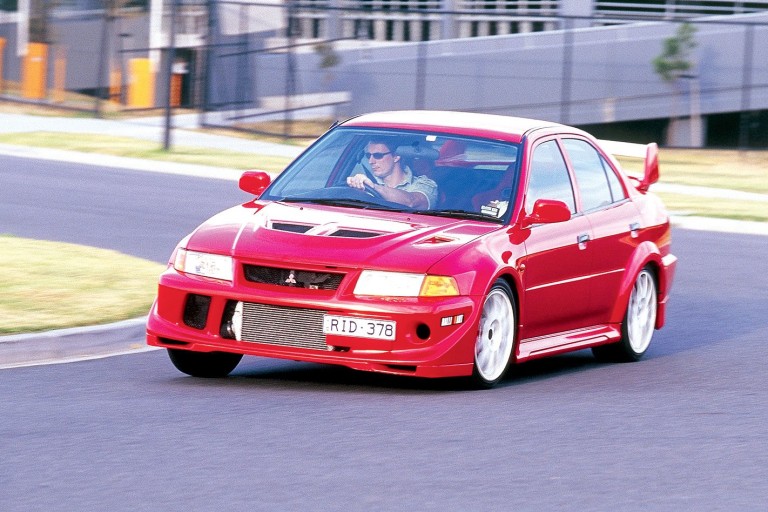
There will always be cars that, years after leaving your orbit, will still make your palms sweat and your pulse downshift a gear or two at their very memory. For me and, I suspect, anybody who ever drove one, the Mitsubishi Lancer EVO VI is one such set of wheels.
This article was first published in MOTOR's June 2004 issue.
The EVO VI is a contradiction. On one hand, it’s got every conceivable power and grip technique; on the other, it’s based on the lowly Mitsubishi Lancer, which, in most incarnations, is equal-parts shopping jeep and accountant’s choice.
As far as Mitsubishi was concerned, however, the EVO VI was really only built with one thing in mind: to win the World Rally Championship. Needing to tackle Subaru’s Impreza WRX STi, Peugeot 206 GTis, and the RS Fords head-on, it’s no surprise, then, that in the EVO VI, Mitsubishi pulled out every trick and spannered up one heck of a hellcat.
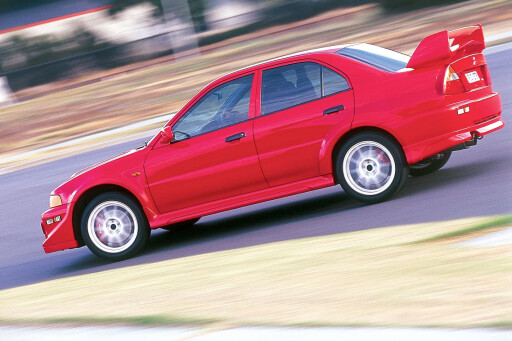 Transverse four-cylinder engine aside, one of the biggest factors in the Lancer’s transformation to EVO VI was its all-wheel-drive system. A constant system with a centre diff, the Lancer’s was special for not imposing on the car the usual pre-apex push that buggers up so many other all-paw weapons. Where Subaru had to resort to a limited-slip front diff in the STi version of the latter-day Rex (with less of a result), the EVO just seemed to have the right torque split and attitude for every situation. Throw in big wheels and tyres and you’ve cracked it for that rare achievement of matching tyre to mechanical grip.
Transverse four-cylinder engine aside, one of the biggest factors in the Lancer’s transformation to EVO VI was its all-wheel-drive system. A constant system with a centre diff, the Lancer’s was special for not imposing on the car the usual pre-apex push that buggers up so many other all-paw weapons. Where Subaru had to resort to a limited-slip front diff in the STi version of the latter-day Rex (with less of a result), the EVO just seemed to have the right torque split and attitude for every situation. Throw in big wheels and tyres and you’ve cracked it for that rare achievement of matching tyre to mechanical grip.
On a race-track, the EVO VI just can’t be tricked into doing anything nasty, despite the outrageous speeds of which it’s capable. Stopping power and pedal feel are not things the EVO is short on. On public roads, it’s safe, secure and totally unflappable. The caveat here, though, is that if you do get it wrong in an EVO VI, your crunch will be a big one – that’s the only size they come in.
The EVO’s stumpy little bonnet was packed with a fire-breathing version of a production Mitsubishi two-litre four-banger. It scored a twin-camshaft head, four valves per cylinder and measured 1997cc, thanks to a bore of 85mm and a stroke of 88mm. That bore-stroke relationship is important, because it makes the mill undersquare, and, as we all know (don’t we?) long-stroke engines rev slower (relatively) and are capable of achieving better cylinder-fill, so they’re dead-set perfect for forced induction.
 And there’s the big EVO VI addition: a dirty great snail feeding the 8.8:1 compression ratio engine with a big old dose of intercooled huff. Power maxed out at a claimed 206kW – the Japanese government-enforced maximum, after which every car had to be emission-tested individually. Frankly, the EVO VI felt like it might have had a good blob more than 206 – a cynic might suggest closer to 220, even 230kW – but 206 at 6500rpm remained the factory claim.
And there’s the big EVO VI addition: a dirty great snail feeding the 8.8:1 compression ratio engine with a big old dose of intercooled huff. Power maxed out at a claimed 206kW – the Japanese government-enforced maximum, after which every car had to be emission-tested individually. Frankly, the EVO VI felt like it might have had a good blob more than 206 – a cynic might suggest closer to 220, even 230kW – but 206 at 6500rpm remained the factory claim.
More significant, though, was its turbo engine’s torque: it peaked at a V8-like 373Nm, but it did so at just 3000rpm, which makes monkeys of both Ford’s and Holden’s current-model big-inch V8s. With a good chunk of that 373Nm on tap well below 3000rpm, you can see that there’s not really a hole of any sort in the EVO’s performance graph.
Dump the clutch in first and, thanks to its awesome grip, by the time the thing has spooled up full boost, you’ll be hanging by your wrists from its wheel. Don’t get comfy, though, because soon you’ll be bashing 7000rpm and the rev-limiter will be calling the shots. Just like first, the next ratio lasts just a second or two before you’re shoving the stick away towards third. And guess what? Yep, same deal – even fourth gear disappears all too soon thanks to its combination of fairly short overall gearing and massive stomp.
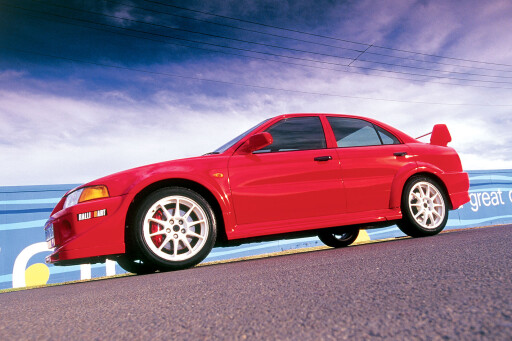 So let’s get all this performance into perspective, shall we?
So let’s get all this performance into perspective, shall we?
A BMW M3 is one of the fastest things around, but even it can’t match the blunt-instrument effectiveness of the EVO VI. Even with all-wheel-drive, the EVO weighs just 1280kg, giving it a power-to-weight ratio of just 6.2kg for every kiloWatt to punch around. The M3’s 6.23kg per kW is similar, but the Mitsubishi hits 100km/h in 5.32 seconds against the BMW’s 5.38. Across the first 400m, the M3 takes 13.59 seconds, but the EVO gets there first in 13.3.
Around a circuit – take the tight and technical Wakefield Park, near Goulburn, NSW – the EVO lunches even the mighty M3. The difference is almost a full two seconds. Phew.
The rest of the deal really isn’t up to BMW standards, however. The EVO feels tinny in the body, and build quality just ain’t there. Inside, it’s relatively sparse, and its body kit is tasteless and of questionable quality, although committed head-bangers will love its general race-car ambience.
 Only the truly demented would want more than the existing hand-grenade potential from an EVO VI, and bear that in mind when looking for a second-hand model: one that has been tweaked will have been driven by a maniac with deep pockets and a death-wish. A stocker is a much better bet, purely because it has probably been treated a little more sympathetically and is considerably less likely to make loud exploding noises next week.
Only the truly demented would want more than the existing hand-grenade potential from an EVO VI, and bear that in mind when looking for a second-hand model: one that has been tweaked will have been driven by a maniac with deep pockets and a death-wish. A stocker is a much better bet, purely because it has probably been treated a little more sympathetically and is considerably less likely to make loud exploding noises next week.
Of course, once you’ve found your stock-as-a-rock EVO VI, and assuming you don’t want a long-term relationship with the thing, they’re actually fairly easy to wind up (see "More is More" below).
When you’re out shopping for a VI, you really can’t go past a professional inspection from a workshop that knows its EVOs. These are such complicated devices that there’s too big a chance of missing something by just climbing underneath with a torch and a prayer.
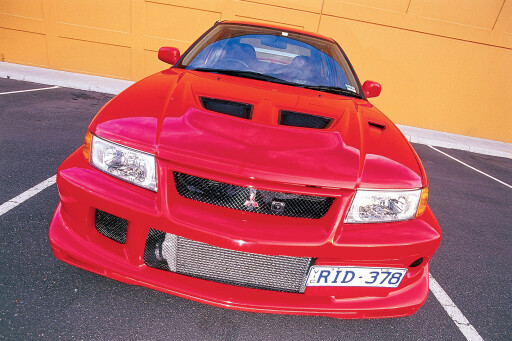 Get the suspect up on a hoist and check for crash damage and evidence – such as bashed in floorpans and a million stone-chips underneath – that the car is either an ex-rally gadget or has been driven hard and hasty over loose surfaces. Holes in the floor where a roll-cage once lived are cause for concern, as are bruises in the dashboard where a Halda resided and shadows on the paint suggesting previous signwriting.
Get the suspect up on a hoist and check for crash damage and evidence – such as bashed in floorpans and a million stone-chips underneath – that the car is either an ex-rally gadget or has been driven hard and hasty over loose surfaces. Holes in the floor where a roll-cage once lived are cause for concern, as are bruises in the dashboard where a Halda resided and shadows on the paint suggesting previous signwriting.
But if you’re lucky enough to find the right one, there’s absolutely no doubt the EVO VI will be a car you’ll remember for a long, long time. And just for once, it’ll be for all the right reasons.
They Said It
“What the EVO does is strip driving to its barest essentials and magnifies the driver’s inputs at least two-fold. Everything about it is immediate, overstated, precise and heaps of fun.”
- Jonathan Hawley, August 2001
“EVO VI grand-slammed every performance benchmark in the category, and was each judge’s clear choice as well. EVO VI is the clear [BFYB] category winner. It’s a wonderfully precise, thoroughly engaging tool built for one job only – to drive at or near the limit, capably.”
- John Cadogan, October 2001
More is More
Want more go from your new road rocket? Start with the exhaust, which, like most turbocars, will yield a surprisingly good gain if it’s a quality system. The next step is a piggy-back computer and a lap-top tune on a dyno. A couple of psi of boost is also possible at this point.
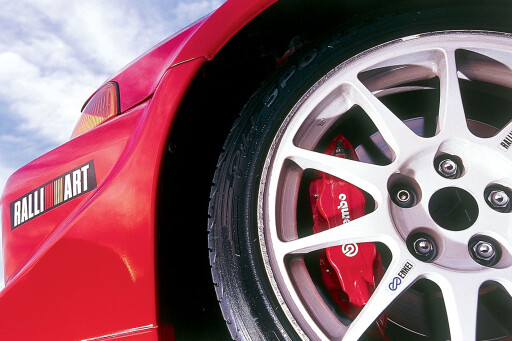 By now you should be looking at some serious numbers, which is just as well, because after that it starts to cost big money.
By now you should be looking at some serious numbers, which is just as well, because after that it starts to cost big money.
A bigger intercooler would be next and maybe some camshaft fiddles and some headwork, but by then you’d really be starting to test the patience of the bottom end.
A full comp spec jobbie should be good for 260kW and 500Nm.
Fast Facts
Mitsubishi EVO VI
BODY: four-door sedan
DRIVE: all-wheel
ENGINE: front-mounted 2.0-litre DOHC 16-valve turbo four
POWER: 206kW @ 6500rpm
TORQUE: 373Nm @ 2750rpm
COMPRESSION: 8.8:1
BORE/STROKE: 85.0mm x 88.0mm
WEIGHT: 1260kg
WEIGHT/POWER: 6.1kg/kW
SPECIFIC POWER: 103kW/litre
TRANSMISSION: five-speed manual
SUSPENSION: MacPherson struts, coil springs, anti-roll bar (f): multi-link, coil springs, anti-roll bar (r)
L/W/H: 4350/1770/1405mm
WHEELBASE: 2510mm
TRACK: 1510mm (f), 1505mm (r)
BRAKES: 376mm ventilated discs, four-piston calipers (f); 320mm ventilated discs, two-piston calipers (r), ABS
WHEELS: 17 x 7.5-inch (f & r), alloy
TYRES: Bridgestone S01, 225/45 ZR17 (f & r)
FUEL: 50 litres, PULP
PRICE: $79,990 (2002)

COMMENTS